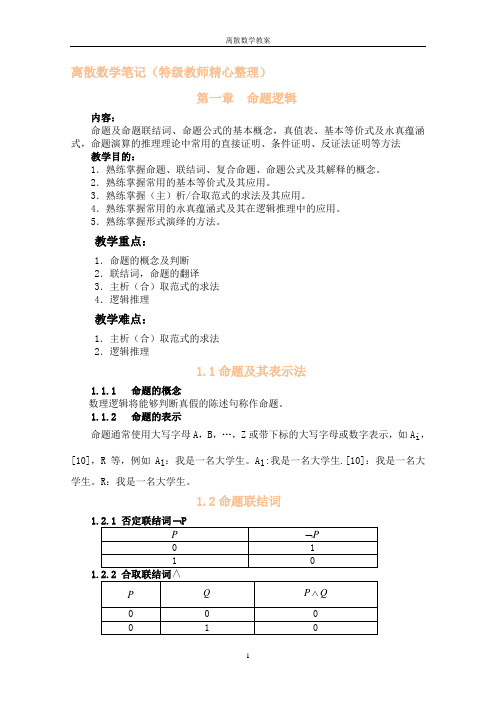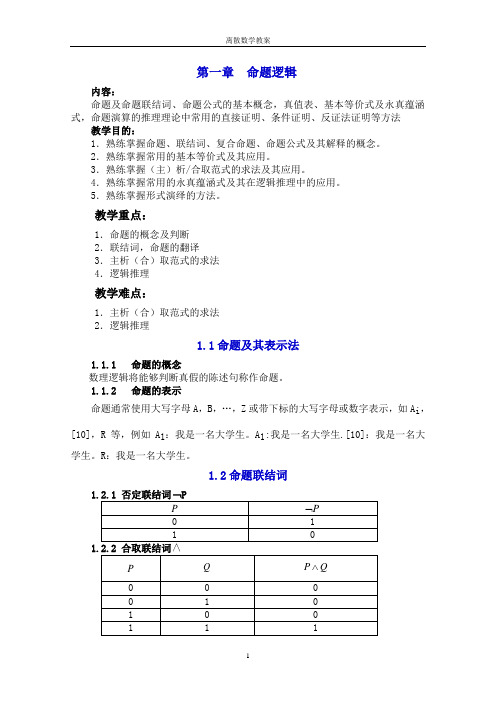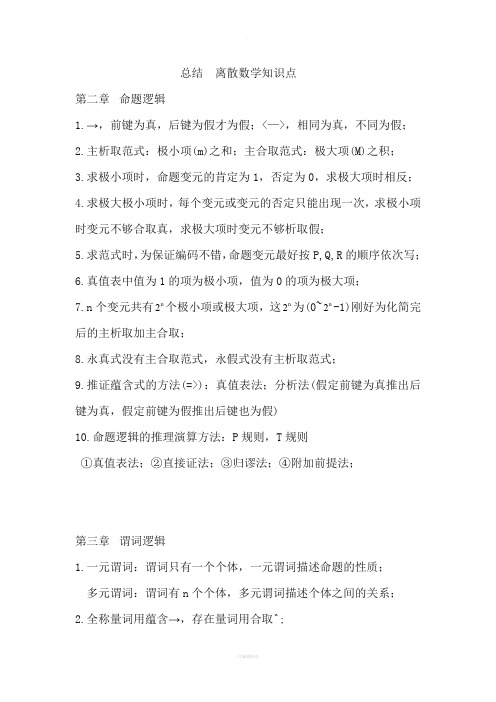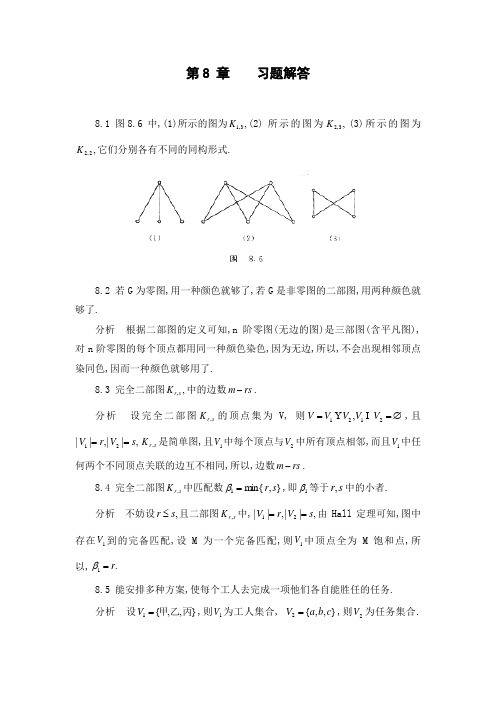哥伦比亚大学-离散数学-笔记-第5-8章-3
离散数学笔记(特级教师精心整理)

离散数学笔记(特级教师精心整理)第一章命题逻辑内容:命题及命题联结词、命题公式的基本概念,真值表、基本等价式及永真蕴涵式,命题演算的推理理论中常用的直接证明、条件证明、反证法证明等方法教学目的:1.熟练掌握命题、联结词、复合命题、命题公式及其解释的概念。
2.熟练掌握常用的基本等价式及其应用。
3.熟练掌握(主)析/合取范式的求法及其应用。
4.熟练掌握常用的永真蕴涵式及其在逻辑推理中的应用。
5.熟练掌握形式演绎的方法。
教学重点:1.命题的概念及判断2.联结词,命题的翻译3.主析(合)取范式的求法4.逻辑推理教学难点:1.主析(合)取范式的求法2.逻辑推理1.1命题及其表示法1.1.1 命题的概念数理逻辑将能够判断真假的陈述句称作命题。
1.1.2 命题的表示命题通常使用大写字母A,B,…,Z或带下标的大写字母或数字表示,如A i,[10],R等,例如A1:我是一名大学生。
A1:我是一名大学生.[10]:我是一名大学生。
R:我是一名大学生。
1.2命题联结词(1) P↑P⇔﹁(P∧P)⇔﹁P;(2)(P↑Q)↑(P↑Q)⇔﹁(P↑Q)⇔ P∧Q;(3)(P↑P)↑(Q↑Q)⇔﹁P↑﹁Q⇔ P∨Q。
(1)P↓P⇔﹁(P∨Q)⇔﹁P;(2)(P↓Q)↓(P↓Q)⇔﹁(P↓Q)⇔P∨Q;(3)(P↓P)↓(Q↓Q)⇔﹁P↓﹁Q⇔﹁(﹁P∨﹁Q)⇔P∧Q。
1.3 命题公式、翻译与解释1.3.1 命题公式定义命题公式,简称公式,定义为:(1)单个命题变元是公式;(2)如果P 是公式,则﹁P是公式;(3)如果P、Q是公式,则P∧Q、P∨Q、P→Q、 P↔Q 都是公式;(4)当且仅当能够有限次的应用(1) 、(2)、(3) 所得到的包括命题变元、联结词和括号的符号串是公式。
例如,下面的符号串都是公式:((((﹁P)∧Q)→R)∨S)((P→﹁Q)↔(﹁R∧S))(﹁P∨Q)∧R以下符号串都不是公式:((P∨Q)↔(∧Q))(∧Q)1.3.2 命题的翻译可以把自然语言中的有些语句,转变成数理逻辑中的符号形式,称为命题的翻译。
离散数学期末总结

离散数学期末总结离散数学是描绘一些离散量与量之间的相互逻辑构造及关系的学科。
它的思想方法及内容渗透到计算机学科的各个领域中。
因此它成为计算机及相关专业的一门重要专业根底课。
主要内容包括:集合论、关系、代数系统、图论和数理逻辑五个部分。
构造上,从集合论入手,后介绍数理逻辑,便于学生学习。
为了能很好的消化理解内容,列举了大量的较为典型、易于承受、说明问题的例题,配备了相当数量的习题,也列举了部分实际应用问题。
一.知识点第一章.集合论集合论或集论是研究集合(由一堆抽象物件构成的整体)的数学理论,包含集合、元素和成员关系等最根本数学概念。
在大多数现代数学的公式化中,集合论提供了要如何描述数学物件的语言。
本章主要介绍集合的根本概念、运算及幂集合和笛卡尔乘积。
这章是本书的根底部分,要学好离散数学就必须很好的掌握集合的内容。
集合论的概念和方法已经渗透到所有的数学分支,因而各数学分支的完整体系,都是在所取集合上。
第二章.关系关系在我们日常生活中经常会遇到关系这一概念。
但在数学中关系表示集合中元素间的联系。
本章主要学习关系的根本概念、关系的性质、闭包运算、次序关系、等价关系,本章学习的重点:关系的性质、闭包运算、次序关系。
关系这一章是集合论这一章的延伸,对集合论的理解程度对学习关系这一章是非常有影响的。
而关系又是学习下一章代数系统必不可少的,所以本章是非常重要的章节。
第三章.代数系统代数构造也叫做抽象代数,主要研究抽象的代数系统。
抽象代数研究的中心问题就是一种很重要的数学构造--代数系统:半群、群等等。
本章主要学习了运算与半群、群。
学习本章需要学会判断是否是代数系统、群和半群,以及判断代数系统具有哪些运算规律,如:结合、交换律等及单位元、逆元。
这些都在我们计算机编码中表达出重要的作用。
第四章.图论图论〔Graph Theory〕起源于著名的柯尼斯堡七桥问题,以图为研究对象。
图论中的图是由假设干给定的点及连接两点的线所构成的图形,这种图形通常用来描述某些事物之间的某种特定关系,用点代表事物,用连接两点的线表示相应两个事物间具有这种关系。
离散数学笔记

第一章命题逻辑内容:命题及命题联结词、命题公式的基本概念,真值表、基本等价式及永真蕴涵式,命题演算的推理理论中常用的直接证明、条件证明、反证法证明等方法教学目的:1.熟练掌握命题、联结词、复合命题、命题公式及其解释的概念。
2.熟练掌握常用的基本等价式及其应用。
3.熟练掌握(主)析/合取范式的求法及其应用。
4.熟练掌握常用的永真蕴涵式及其在逻辑推理中的应用。
5.熟练掌握形式演绎的方法。
教学重点:1.命题的概念及判断2.联结词,命题的翻译3.主析(合)取范式的求法4.逻辑推理教学难点:1.主析(合)取范式的求法2.逻辑推理1.1命题及其表示法1.1.1 命题的概念数理逻辑将能够判断真假的陈述句称作命题。
1.1.2 命题的表示命题通常使用大写字母A,B,…,Z或带下标的大写字母或数字表示,如A i,[10],R等,例如A1:我是一名大学生。
A1:我是一名大学生.[10]:我是一名大学生。
R:我是一名大学生。
1.2命题联结词(1) P↑P⇔﹁(P∧P)⇔﹁P;(2)(P↑Q)↑(P↑Q)⇔﹁(P↑Q)⇔ P∧Q;(3)(P↑P)↑(Q↑Q)⇔﹁P↑﹁Q⇔ P∨Q。
(1)P↓P⇔﹁(P∨Q)⇔﹁P;(2)(P↓Q)↓(P↓Q)⇔﹁(P↓Q)⇔P∨Q;(3)(P↓P)↓(Q↓Q)⇔﹁P↓﹁Q⇔﹁(﹁P∨﹁Q)⇔P∧Q。
1.3 命题公式、翻译与解释1.3.1 命题公式定义命题公式,简称公式,定义为:(1)单个命题变元是公式;(2)如果P 是公式,则﹁P是公式;(3)如果P、Q是公式,则P∧Q、P∨Q、P→Q、 P↔Q 都是公式;(4)当且仅当能够有限次的应用(1) 、(2)、(3) 所得到的包括命题变元、联结词和括号的符号串是公式。
例如,下面的符号串都是公式:((((﹁P)∧Q)→R)∨S)((P→﹁Q)↔(﹁R∧S))(﹁P∨Q)∧R以下符号串都不是公式:((P∨Q)↔(∧Q))(∧Q)1.3.2 命题的翻译可以把自然语言中的有些语句,转变成数理逻辑中的符号形式,称为命题的翻译。
离散数学大纲

离散数学教学大纲第一部分大纲说明一.课程的性质与任务《离散数学》是现代数学的一个重要分支,也是计算机计算机科学与技术一级学科及其相关专业必修的基础理论的核心课程。
它是学习后续专业课程不可缺少的数学工具。
该课程结合计算机学科的特点,主要研究离散量结构及相互关系,其研究对象一般是有限个或可数个元素,因此《离散数学》充分描述了计算机学科离散性的特点。
它是一门理论性较强,应用性较广的课程。
掌握集合论、数理逻辑、图论、整数、群、环、域、格、布尔代数以及语言与有限自动机等离散数学的基本概念和基本原理,为学习计算机专业各后续课程做好必要的知识准备。
并通过这些知识的学习进一步提高学生的抽象思维和逻辑推理能力,为从事计算机相关的理论研究与应用提供必要的描述工具和理论基础。
二《离散数学》的特点作为计算机科学与技术一级学科的一门课程,《离散数学》有与其他课程相同相似的地方,当然也有它自身的特点:1、义与定理多。
《离散数学》是建立在大量定义之上的逻辑推理学科,因此对概念的理解是我们学习这门课程的核心。
在学习这些概念的基础上,要特别注意概念之间的联系,而描述这些联系的实体则是大量的定理与性质。
2、法性强。
《离散数学》的许多证明题中,方法性是非常强的,如果知道题的证明方法,很容易就可以证出来,反之则事倍功半。
所以在学习该课程中要善于总结,勤于思考,这也是培养分析问题解决问题抽象思维能力的一个过程。
三与其他相关课程的关系先修课程:高等数学(包括数学分析、线性代数)后续课程:数据结构、数据库、编译原理等四课程的主要内容与基本要求本课程分为九部分:集合论基础、命题逻辑、谓词逻辑、图与网络、数论基础、群与环、多项式与有限域、格与布尔代数以及语言和有限自动机。
(一)集合论基础:在整个《离散数学》的知识体系中,集合论处于基础的地位,对于其所包含知识的掌握程度,直接关系到是否能学好图论和抽象代数问题。
本章主要讲述集合、关系和映射。
1. 掌握集合、子集、超集、空集、幂集、集合族的概念。
离散数学第五章习题答案

离散数学第五章习题答案题目1: 定义一个关系R在集合A上,如果对于所有的a, b, c属于A,满足以下条件:- 如果(a, b)属于R,则(b, a)属于R。
- 如果(a, b)属于R且(b, c)属于R,则(a, c)属于R。
证明R是传递的。
答案:根据题目给出的条件,R是对称的和传递的。
首先,对称性意味着如果(a, b)属于R,那么(b, a)也必须属于R。
其次,传递性意味着如果(a, b)和(b, c)都属于R,那么(a, c)也必须属于R。
结合这两个性质,我们可以得出结论:对于任意的a, b, c属于A,如果(a, b)和(b, c)都属于R,那么(a, c)也属于R,从而证明了R的传递性。
题目2: 给定一个函数f: A → B,如果对于A中的每个元素a,都有唯一的b属于B使得f(a) = b,那么称f为单射(或一一映射)。
证明如果函数f是单射,那么它的逆函数f^-1也是单射。
答案:要证明f^-1是单射,我们需要证明对于B中的任意两个元素b1和b2,如果f^-1(b1) = f^-1(b2),则b1 = b2。
假设f^-1(b1) = a且f^-1(b2) = a',其中a, a'属于A。
由于f是单射,我们知道f(a) = b1且f(a') = b2。
根据f^-1的定义,我们有b1 = f(a) = f(a') = b2。
因此,如果f^-1(b1) = f^-1(b2),则b1必须等于b2,这证明了f^-1是单射。
题目3: 证明一个函数f: A → B是满射(或到上映射)当且仅当对于B中的每个元素b,都存在A中的元素a使得f(a) = b。
答案:首先,我们证明如果f是满射,那么对于B中的每个元素b,都存在A 中的元素a使得f(a) = b。
假设f是满射,这意味着B中的每个元素都是A中某个元素的像。
因此,对于B中的任意元素b,我们可以找到一个a属于A,使得f(a) = b。
离散数学(图论)课后总结

第八章图论例1、下面哪些数的序列,可能是一个图的度数序列?如果可能,请试画出它的图. 哪些可能不是简单图?a) (1,2,3,4,5) b) (2,2,2,2,2) c) (1,2,3,2,4) d) (1,1,1,1,4) e) (1,2, 2,4,5)解:a)不是, 因为有三个数字是奇数. b) c) d)是.e) 不是简单图,因为它有5个结点, 有一个结点度为5, 必然有环或平行边.例2、已知无向简单图G中,有10条边,4个3度结点,其余结点的度均小于或等于2,问G中至少有多少个结点?为什么?解:已知边数|E|=10, ∑deg(v)=2|E|=20其中有4个3度结点, 余下结点度之和为: 20-3×4=8 因为G是简单图, 其余每个结点度数≤2, 所以至少还有4个结点.所以G中至少有8个结点.强连通、单侧连通和弱连通在简单有向图G中,如果任何两个结点间相互可达, 则称G是强连通. 如果任何一对结点间, 至少有一个结点到另一个结点可达, 则称G是单侧连通. 如果将G看成无向图后(即把有向边看成无向边)是连通的,则称G是弱连通.在简单有向图中,具有强连通的最大子图,称为强分图.具有单侧连通的最大子图,称为单侧分图. 具有弱连通的最大子图,称为弱分图.注:我每次都会被各种分图弄糊涂!!考试时要注意啊,千万不要错了利用可达性矩阵求强分图,注意初等矩阵变换的知识不要忘了!!令图G=<V,E,W>, 集合Si V Si’=V-Si , 令|V|=nSi={u|从u0到u的最短路已求出}Si’={u’|从u0到u’的最短路未求出}Dijkstra算法:(求从u0到各点u的最短路长)第一步. 置初值: d(u0,u0)=0 d(u0,v)=∞(其中v≠u0)i=0 S0={u0} S0’=V-S0 ,第二步.若i=n-1 则停. 否则转第三步第三步. 对每个u’∈Si’计算d(u0,u’)=min{d(u0,u’), d(u0,ui)+c(ui,u’)} ui ∈Si计算min{d(u0,u’)}u’∈S i’并用ui+1记下达到该最小值的那个结点u’置Si+1 =Si∪{ui+1} i=i+1 Si’=V-Si , 转第二步.例3、求最短路解:例.求右图中从v1到v6的最短路1.置初值: u0=v1d(u0,u0)=0d(u0,v2)=d(u0,v3)=d(u0,v4)=d(u0,v5)=d(u0,v6)=∞2.3. i=0 S0={v1} S0’={v2,v3,v4,v5,v6}d(u0,v2)=min{d(u0,v2), d(u0,u0)+c(u0,v2)}=min{∞,0+3}=3d(u0,v3)=min{d(u0,v3),d(u0,u0)+c(u0,v3)}=min{∞,0+∞}=∞d(u0,v4)=min{d(u0,v4), d(u0,u0)+c(u0,v4)}=min{∞,0+5}=5d(u0,v5)=min{d(u0,v5),d(u0,u0)+c(u0,v5)}=min{∞,0+∞}=∞d(u0,v6)=min{d(u0,v6),d(u0,u0)+c(u0,v6)}=min{∞,0+∞}=∞min{3,∞,5, ∞,∞}=3ui+1 =u1=v2 , 实际已求出d(u0,v2)=3, 路是u0v2i=1 S1={v1, v2}S1’={v3,v4,v5,v6}u1=v2d(u0,u1)=3d(u0,v3)=min{d(u0,v3),d(u0,u1)+c(u1,v3)}=min{∞,3+6}=9d(u0,v4)=min{d(u0,v4), d(u0,u1)+c(u1,v4)}=min{5,3+1}=4d(u0,v5)=min{d(u0,v5),d(u0,u1)+c(u1,v5)}=min{∞,3+∞}=∞d(u0,v6)=min{d(u0,v6),d(u0,u1)+c(u1,v6)}=min{∞,3+∞}=∞min{9,4,∞,∞}=4ui+1 =u2=v4 , 实际已求出d(u0,v4)=4, 路是u0v2v4i=2 S2={v1, v2 ,v4}S2’={v3,v5,v6}u2=v4d(u0,u2)=4d(u0,v3)=min{d(u0,v3), d(u0,u2)+c(u2,v3)}=min{9 ,4+3}=7d(u0,v5)=min{d(u0,v5), d(u0,u2)+c(u2,v5)}=min{∞,4+1}=5d(u0,v6)=min{d(u0,v6), d(u0,u2)+c(u2,v6)}=min{∞,4+∞}=∞min{7,5,∞}=5ui+1 =u3=v5 , 实际已求出d(u0,v5)=5, 路是u0v2v4 v5i=3 S3={v1, v2 ,v4 ,v5}S3’={v3,v6}u3=v5d(u0,u3)=5d(u0,v3)=min{d(u0,v3),d(u0,u3)+c(u3,v3)}=min{7 ,5+3}=7d(u0,v6)=min{d(u0,v6),d(u0,u3)+c(u3,v6)}=min{∞,5+6}=11 min{7,11}=7ui+1 =u4=v3 , 实际已求出d(u0,v3)=7, 路是u0v2v4 v3i=4 S3={v1, v2 ,v4 ,v5, v3} S3’={v6} u4=v3 d(u0,u4)=7 d(u0,v6)=min{d(u0,v6),d(u0,u4)+c(u4,v6)}=min{11,7+3}=10min{10}=10ui+1 =u5=v6 , 实际已求出d(u0,v6)=10, 路是u0v2v4 v3 v6i=5 (n-1) 时算法停止.例4、求关键路径。
离散数学第五章 函数

像与逆像: 映射的“提升”
设U和V是两个集合, f : U→V 是从U到V的一个函数, ρ(U)是U的幂集,ρ(V)是V的幂集。
像与逆像将从U到V的一个映射 f : U→V “提升” 为从U的幂集 ρ(U) 到V的幂集 ρ(V) 的映射
集合 A 在函数 f 下的 像 f (A)
U
f
V
A
f(A)
集合 B 在函数 f 下的 逆像 f -1(B)
U
f
V
-1
f (B)
B
例5.1.3 设 A={a, b, c, d, e} , B={1, 2, 3, 4} , φ: A→B, φ的定义如图所示。则
φ({a, b, c})={1, 2}
例:设 U={1,2,3,4},V={1,2,…,16},关系 f1={ <1,1>, <2,4>, <3,9>, <4,16> }, f2={ <1,1>, <2,3>, <4,4> }, f3={ <1,1>, <1,2>, <2,15>, <3,16>, <4,1> },
试判断哪些是函数?
解:f1 是,且 f1(a)=a2。 f2 不是,因为f2(3)=? f3 不是,因为两个f3(1)。
n×n×…×n = nm
m
映射:递归定义
例5.1.8 (1) 阶乘 n! f: N→N, f(0)=1, f(n+1)=f(n)(n+1), n∈N。
(但需要检查,是否都有射,是否没有一射多)
离散数学第五章__谓词逻辑详述

又如,在命题“武汉位于北京和广州之间” 中,武汉、北京和广州是三个个体,而“…位 于…和…之间”是谓词,它刻划了武汉、北京和 广州之间的关系。设P:…位于…和…之间,a: 武汉,b:北京,c:广州,则
P(a,b,c):武汉位于北京和广州之间。
定义5.1.2 一个原子命题用一个谓词(如P)和n 个有次序的个体常元(如a1,a2,…,an)表示 成P(a1,a2,…,an),称它为该原子命题的谓 词形式或命题的谓词形式。
注意:
1. n元谓词不是命题,只有其中的个体变元用特定个体或个 体常元替代时,才能成为一个命题。
例如,令S(x):x是大学生,这是一元谓词,不是命题; S(c):张明是位大学生,这就是一个命题。 2. 个体变元在哪些论域取特定的值,对命题的真值有影响。
例如,令S(x):x是大学生。若x的论域为某大学的计 算机系中的全体同学,则S(x)是真的;若x的论域是某中 学的全体学生,则S(x)是假的;若x的论域是某剧场中的 观众,且观众中有大学生也有非大学生的其它观众,则 S(x)是真值是不确定的。
例如,著名的亚里士多德三段论苏格拉底推理: 所有的人都是要死的, 苏格拉底是人, 所以苏格拉底是要死的。
根据常识,认为这个推理是正确的。若用命题逻 辑来表示,设P、Q和R分别表示这三个原子命题, 则有
P,Q┣ R
(P∧Q)→P, (P∧Q)→Q都是永真式
然而,(P∧Q)→R并不是永真式,故上述推理形 式又是错误的。一个推理,得出矛盾的结论, 问题在哪里呢? 问题就在于这类推理中,各命题 之间的逻辑关系不是体现在原子命题之间,而 是体现在构成原子命题的内部成分之间,即体 现在命题结构的更深层次上。对此,命题逻辑 是无能为力的。所以,在研究某些推理时,有 必要对原子命题作进一步分析,分析出其中的 个体词,谓词和量词,研究它们的形式结构的 逻辑关系、正确的推理形式和规则,这些正是 谓词逻辑的基本内容。
笔记离散数学

离散数学复习笔记数理逻辑逻辑:以研究人的思维形式及思维规律为目的的一门学科数理逻辑:利用数学符号来协助推理的一门形式逻辑学命题:能表达判断并具有确定真值的陈述句真值:每个命题都具有的一个值,要么为真,要么为假,不能随着环境变化原子命题:不能再分解的命题复合命题:由原子命题符号及联结词组成的有意义的命题表达式否定非P 合取P而且Q 析取P可兼或Q 排斥析取P不可兼或Q 单条件若P 则Q 双条件P当且仅当Q命题公式:满足特定条件的合法的命题表达式分量:命题公式中的原子命题翻译:将自然语言转化为数理逻辑语言真值表:对一个命题公式而言,将对于其分量的各种可能的真值指派汇聚成的表两个命题等价:对两个命题公式A,B,若对于A\B中的所有命题变元P1\P2..对天安门的任一组真值指派A,B相同对应的行的真值相同,则称A与B等价等价定律:交换律,结合律,分配律,摩根律,否定律,同一律重言式:永真式,无论对命题变元作何种真值指派,它都等价于T的命题公式永假式:无论对命题变元作何种真值指派,它都等价于F的命题公式用一个命题公式代替重言式中同一个分量,依然为重言式蕴含式:若A->B永真则称A蕴含B,记做A=>B原命题等价于它的逆否命题三个性质:传递性,A=>B A=>C A=>(B^C), A=>B C=>B AvC=>B有效结论:H1,H2、、、、Hn,C为一组命题公式,若H1^H2^...^Hn=>C,称C 是一组条件下的有效结论三种方法:真值表法,直接证法,间接证法其他连接词:条件否定,与非,或非规范命题表达式:只含非且或合取范氏:当且仅当具有A1^A2^...^An形式,A1,A2...An都是命题变元或其否定组成的析取式析取范式:当且仅当具有A1vA2v...vAn形式,A1,A2...An都是命题变元或其否定组成的合取式一个命题公式的合取范氏或析取范氏并不是唯一的n个命题变元的合取式,称作布尔合取或小项,其中每个变元与它的否定不能同时存在,但两者必须出现且仅出现一次 P^Q P^非Q一般n个命题变元共有2^n个小项n个命题变元的析取式,称作布尔析取或大项,其中每个变元与它的否定不能同时存在,但两者必须出现且仅出现一次 PvQ Pv非Q主析取范式:对于给定的命题公式,如果有一个等价公式,它仅由小项的析取所组成,则称该等价式为原式的主析取范式主合取范式:对于给定的命题公式,如果有一个等价公式,它仅由大项的合取所组成,则称该等价式为原式的主合取范式集合论集合:满足一定特征的对象的全体扩张原则:两个集合相等,当且仅当他们有相同的元素抽象原则:任给一个集合U和一个性质P,存在一个集合A,使得A的各个元素恰好是U的具有性质P的那些成员集合表示:列举法,特征法幂集:对给定的集合A,称以A的全体子集为元素的集合为A的幂集集合的基数:|A|元素的个数无限集合:元素个数能与某个真子集一一对应的集合序偶:有序的二元数组<x,y>笛卡尔积:称A*B={<x,y>|x属于A且y属于B}二元关系:以序偶作为元素的集合即关系xRy,关系前域指x,关系值域指y,关系域是前域和值域的并集。
离散数学图论整理

总 结第八章 图论8.1 图的基本概念8.1.1 图定义8.1―1 一个图G 是一个三重组〈V (G ),E (G ),ΦG 〉,其中V (G )是一个非空的结点(或叫顶点)集合,E (G )是边的集合,ΦG 是从边集E 到结点偶对集合上的函数。
一个图可以用一个图形表示。
定义中的结点偶对可以是有序的,也可以是无序的。
若边e 所对应的偶对〈a ,b 〉是有序的,则称e 是有向边。
有向边简称弧,a 叫弧e 的始点,b 叫弧e 的终点,统称为e 的端点。
称e 是关联于结点a 和b 的,结点a 和结点b 是邻接的。
若边e 所对应的偶对(a ,b )是无序的,则称e 是无向边。
无向边简称棱,除无始点和终点的术语外,其它术语与有向边相同 每一条边都是有向边的图称为有向图。
每一条边都是无向边的图称为无向图。
有向图和无向图也可互相转化。
例如,把无向图中每一条边都看作两条方向不同的有向边,这时无向图就成为有向图。
又如,把有向图中每条有向边都看作无向边,就得到无向图。
这个无向图习惯上叫做该有向图的底图。
在图中,不与任何结点邻接的结点称为弧立结点。
全由孤立结点构成的图称为零图。
关联于同一结点的一条边称为自回路。
在有向图中,两结点间(包括结点自身间)若同始点和同终点的边多于一条,则这几条边称为平行边。
在无向图中,两结点间(包括结点自身间)若多于一条边,则称这几条边为平行边。
两结点a 、b 间互相平行的边的条数称为边[a ,b ]的重数。
仅有一条时重数为1,无边时重数为0。
定义8.1―2 含有平行边的图称为多重图。
非多重图称为线图。
无自回路的线图称为简单图。
仅有一个结点的简单图称为平凡图。
定义 8.1―3 赋权图G 是一个三重组〈V ,E ,g 〉或四重组〈V ,E ,f ,g 〉,其中V 是结点集合, E 是边的集合,f 是定义在V 上的函数,g 是定义在E 上的函数。
8.1.2 结点的次数定义 8.1―4 在有向图中,对于任何结点v ,以v 为始点的边的条数称为结点v 的引出次数(或出度),记为deg +(v );以v 为终点的边的条数称为结点v 的引入次数(或入度),记为deg -(v );结点v 的引出次数和引入次数之和称为结点v 的次数(或度数),记作deg (v )。
离散数学知识点总结

总结离散数学知识点第二章命题逻辑1.→,前键为真,后键为假才为假;<—>,相同为真,不同为假;2.主析取范式:极小项(m)之和;主合取范式:极大项(M)之积;3.求极小项时,命题变元的肯定为1,否定为0,求极大项时相反;4.求极大极小项时,每个变元或变元的否定只能出现一次,求极小项时变元不够合取真,求极大项时变元不够析取假;5.求范式时,为保证编码不错,命题变元最好按P,Q,R的顺序依次写;6.真值表中值为1的项为极小项,值为0的项为极大项;7.n个变元共有n2个极小项或极大项,这n2为(0~n2-1)刚好为化简完后的主析取加主合取;8.永真式没有主合取范式,永假式没有主析取范式;9.推证蕴含式的方法(=>):真值表法;分析法(假定前键为真推出后键为真,假定前键为假推出后键也为假)10.命题逻辑的推理演算方法:P规则,T规则①真值表法;②直接证法;③归谬法;④附加前提法;第三章谓词逻辑1.一元谓词:谓词只有一个个体,一元谓词描述命题的性质;多元谓词:谓词有n个个体,多元谓词描述个体之间的关系;2.全称量词用蕴含→,存在量词用合取^;3.既有存在又有全称量词时,先消存在量词,再消全称量词;第四章集合1.N,表示自然数集,1,2,3……,不包括0;2.基:集合A中不同元素的个数,|A|;3.幂集:给定集合A,以集合A的所有子集为元素组成的集合,P(A);4.若集合A有n个元素,幂集P(A)有n2个元素,|P(A)|=||2A=n2;5.集合的分划:(等价关系)①每一个分划都是由集合A的几个子集构成的集合;②这几个子集相交为空,相并为全(A);6.集合的分划与覆盖的比较:分划:每个元素均应出现且仅出现一次在子集中;覆盖:只要求每个元素都出现,没有要求只出现一次;第五章关系1.若集合A有m个元素,集合B有n个元素,则笛卡尔A×B的基数为2种不同的关系;mn,A到B上可以定义mn2.若集合A有n个元素,则|A×A|=2n,A上有22n个不同的关系;3.全关系的性质:自反性,对称性,传递性;空关系的性质:反自反性,反对称性,传递性;全封闭环的性质:自反性,对称性,反对称性,传递性;4.前域(domR):所有元素x组成的集合;后域(ranR):所有元素y组成的集合;5.自反闭包:r(R)=RUI;x对称闭包:s(R)=RU1-R;传递闭包:t(R)=RU2R U3R U……6.等价关系:集合A上的二元关系R满足自反性,对称性和传递性,则R称为等价关系;7.偏序关系:集合A上的关系R满足自反性,反对称性和传递性,则称R是A上的一个偏序关系;8.covA={<x,y>|x,y属于A,y盖住x};9.极小元:集合A中没有比它更小的元素(若存在可能不唯一);极大元:集合A中没有比它更大的元素(若存在可能不唯一);最小元:比集合A中任何其他元素都小(若存在就一定唯一);最大元:比集合A中任何其他元素都大(若存在就一定唯一);10.前提:B是A的子集上界:A中的某个元素比B中任意元素都大,称这个元素是B的上界(若存在,可能不唯一);下界:A中的某个元素比B中任意元素都小,称这个元素是B的下界(若存在,可能不唯一);上确界:最小的上界(若存在就一定唯一);下确界:最大的下界(若存在就一定唯一);第六章函数2种不同的关系,有m n种不同的函1.若|X|=m,|Y|=n,则从X到Y有mn数;2.在一个有n个元素的集合上,可以有22n种不同的关系,有n n种不同的函数,有n!种不同的双射;3.若|X|=m,|Y|=n,且m<=n,则从X到Y有A m n种不同的单射;4.单射:f:X-Y,对任意x,2x属于X,且1x≠2x,若f(1x)≠f(2x);1满射:f:X-Y,对值域中任意一个元素y在前域中都有一个或多个元素对应;双射:f:X-Y,若f既是单射又是满射,则f是双射;5.复合函数:fºg=g(f(x));6.设函数f:A-B,g:B-C,那么①如果f,g都是单射,则fºg也是单射;②如果f,g都是满射,则fºg也是满射;③如果f,g都是双射,则fºg也是双射;④如果fºg是双射,则f是单射,g是满射;第七章代数系统1.二元运算:集合A上的二元运算就是2A到A的映射;2.集合A上可定义的二元运算个数就是从A×A到A上的映射的个数,即从从A×A到A上函数的个数,若|A|=2,则集合A上的二元运算的个数为2*22=42=16种;3.判断二元运算的性质方法:①封闭性:运算表内只有所给元素;②交换律:主对角线两边元素对称相等;③幂等律:主对角线上每个元素与所在行列表头元素相同;④有幺元:元素所对应的行和列的元素依次与运算表的行和列相同;⑤有零元:元素所对应的行和列的元素都与该元素相同;4.同态映射:<A,*>,<B,^>,满足f(a*b)=f(a)^f(b),则f为由<A,*>到<B,^>的同态映射;若f是双射,则称为同构;第八章群1.广群的性质:封闭性;半群的性质:封闭性,结合律;含幺半群(独异点):封闭性,结合律,有幺元;群的性质:封闭性,结合律,有幺元,有逆元;2.群没有零元;3.阿贝尔群(交换群):封闭性,结合律,有幺元,有逆元,交换律;4.循环群中幺元不能是生成元;5.任何一个循环群必定是阿贝尔群;第十章格与布尔代数1.格:偏序集合A中任意两个元素都有上、下确界;2.格的基本性质:1) 自反性a≤a 对偶: a≥a2) 反对称性a≤b ^ b≥a => a=b对偶:a≥b ^ b≤a => a=b3) 传递性a≤b ^ b≤c => a≤c对偶:a≥b ^ b≥c => a≥c4) 最大下界描述之一a^b≤a 对偶 avb≥aA^b≤b 对偶 avb≥b5)最大下界描述之二c≤a,c≤b => c≤a^b对偶c≥a,c≥b =>c≥avb6) 结合律a^(b^c)=(a^b)^c对偶 av(bvc)=(avb)vc7)等幂律a^a=a 对偶 ava=a8) 吸收律a^(avb)=a 对偶 av(a^b)=a9) a≤b <=> a^b=a avb=b10) a≤c,b≤d => a^b≤c^d avb≤cvd11) 保序性b≤c => a^b≤a^c avb≤avc12)分配不等式av(b^c)≤(avb)^(avc)对偶 a^(bvc)≥(a^b)v(a^c)13)模不等式a≤c <=> av(b^c)≤(avb)^c3.分配格:满足a^(bvc)=(a^b)v(a^c)和av(b^c)=(avb)^(avc);4.分配格的充要条件:该格没有任何子格与钻石格或五环格同构;5.链格一定是分配格,分配格必定是模格;6.全上界:集合A中的某个元素a大于等于该集合中的任何元素,则称a为格<A,<=>的全上界,记为1;(若存在则唯一)全下界:集合A中的某个元素b小于等于该集合中的任何元素,则称b为格<A,<=>的全下界,记为0;(若存在则唯一)7.有界格:有全上界和全下界的格称为有界格,即有0和1的格;8.补元:在有界格内,如果a^b=0,avb=1,则a和b互为补元;9.有补格:在有界格内,每个元素都至少有一个补元;10.有补分配格(布尔格):既是有补格,又是分配格;11.布尔代数:一个有补分配格称为布尔代数;第十一章图论1.邻接:两点之间有边连接,则点与点邻接;2.关联:两点之间有边连接,则这两点与边关联;3.平凡图:只有一个孤立点构成的图;4.简单图:不含平行边和环的图;5.无向完全图:n个节点任意两个节点之间都有边相连的简单无向图;有向完全图:n个节点任意两个节点之间都有边相连的简单有向图;6.无向完全图有n(n-1)/2条边,有向完全图有n(n-1)条边;7.r-正则图:每个节点度数均为r的图;8.握手定理:节点度数的总和等于边的两倍;9.任何图中,度数为奇数的节点个数必定是偶数个;10.任何有向图中,所有节点入度之和等于所有节点的出度之和;11.每个节点的度数至少为2的图必定包含一条回路;12.可达:对于图中的两个节点v,j v,若存在连接i v到j v的路,则称i vi与v相互可达,也称i v与j v是连通的;在有向图中,若存在i v到j v的j路,则称v到j v可达;i13.强连通:有向图章任意两节点相互可达;单向连通:图中两节点至少有一个方向可达;弱连通:无向图的连通;(弱连通必定是单向连通)14.点割集:删去图中的某些点后所得的子图不连通了,如果删去其他几个点后子图之间仍是连通的,则这些点组成的集合称为点割集;割点:如果一个点构成点割集,即删去图中的一个点后所得子图是不连通的,则该点称为割点;15.关联矩阵:M(G),m是i v与j e关联的次数,节点为行,边为列;ij无向图:点与边无关系关联数为0,有关系为1,有环为2;有向图:点与边无关系关联数为0,有关系起点为1终点为-1,关联矩阵的特点:无向图:①行:每个节点关联的边,即节点的度;②列:每条边关联的节点;有向图:③所有的入度(1)=所有的出度(0);16.邻接矩阵:A(G),a是i v邻接到j v的边的数目,点为行,点为列;ij17.可达矩阵:P(G),至少存在一条回路的矩阵,点为行,点为列; P(G)=A(G)+2A(G)+3A(G)+4A(G)可达矩阵的特点:表明图中任意两节点之间是否至少存在一条路,以及在任何节点上是否存在回路;A(G)中所有数的和:表示图中路径长度为1的通路条数;2A(G)中所有数的和:表示图中路径长度为2的通路条数;3A(G)中所有数的和:表示图中路径长度为3的通路条数;4A(G)中所有数的和:表示图中路径长度为4的通路条数;P(G)中主对角线所有数的和:表示图中的回路条数;18.布尔矩阵:B(G),v到j v有路为1,无路则为0,点为行,点为列;i19.代价矩阵:邻接矩阵元素为1的用权值表示,为0的用无穷大表示,节点自身到自身的权值为0;20.生成树:只访问每个节点一次,经过的节点和边构成的子图;21.构造生成树的两种方法:深度优先;广度优先;深度优先:①选定起始点v;②选择一个与v邻接且未被访问过的节点1v;③从v出发按邻接方向继续访问,当遇到一个节点所1有邻接点均已被访问时,回到该节点的前一个点,再寻求未被访问过的邻接点,直到所有节点都被访问过一次;广度优先:①选定起始点v;②访问与v邻接的所有节点1v,2v,……,k v,这些作为第一层节点;③在第一层节点中选定一个节点v为起点;1④重复②③,直到所有节点都被访问过一次;22.最小生成树:具有最小权值(T)的生成树;23.构造最小生成树的三种方法:克鲁斯卡尔方法;管梅谷算法;普利姆算法;(1)克鲁斯卡尔方法①将所有权值按从小到大排列;②先画权值最小的边,然后去掉其边值;重新按小到大排序;③再画权值最小的边,若最小的边有几条相同的,选择时要满足不能出现回路,然后去掉其边值;重新按小到大排序;④重复③,直到所有节点都被访问过一次;(2)管梅谷算法(破圈法)①在图中取一回路,去掉回路中最大权值的边得一子图;②在子图中再取一回路,去掉回路中最大权值的边再得一子图;③重复②,直到所有节点都被访问过一次;(3)普利姆算法①在图中任取一点为起点v,连接边值最小的邻接点2v;1②以邻接点v为起点,找到2v邻接的最小边值,如果最小边值2比v邻接的所有边值都小(除已连接的边值),直接连接,否则退回1v,1连接v现在的最小边值(除已连接的边值);1③重复操作,直到所有节点都被访问过一次;24.关键路径例2 求PERT图中各顶点的最早完成时间, 最晚完成时间, 缓冲时间及关键路径.解:最早完成时间TE(v1)=0TE(v2)=max{0+1}=1TE(v3)=max{0+2,1+0}=2TE(v4)=max{0+3,2+2}=4TE(v5)=max{1+3,4+4}=8TE(v6)=max{2+4,8+1}=9TE(v7)=max{1+4,2+4}=6TE(v8)=max{9+1,6+6}=12 最晚完成时间TL(v8)=12TL(v7)=min{12-6}=6TL(v6)=min{12-1}=11TL(v5)=min{11-1}=10TL(v4)=min{10-4}=6TL(v3)=min{6-2,11-4,6-4}=2 TL(v2)=min{2-0,10-3,6-4}=2 TL(v1)=min{2-1,2-2,6-3}=0 缓冲时间TS(v1)=0-0=0TS(v2)=2-1=1TS(v3)=2-2=0TS(v4)=6-4=2TS(v5=10-8=2TS(v6)=11-9=2TS(v7)=6-6=0TS(v8)=12-12=0关键路径: v1-v3-v7-v825.欧拉路:经过图中每条边一次且仅一次的通路;欧拉回路:经过图中每条边一次且仅一次的回路;欧拉图:具有欧拉回路的图;单向欧拉路:经过有向图中每条边一次且仅一次的单向路;欧拉单向回路:经过有向图中每条边一次且仅一次的单向回路;26.(1)无向图中存在欧拉路的充要条件:①连通图;②有0个或2个奇数度节点;(2)无向图中存在欧拉回路的充要条件:①连通图;②所有节点度数均为偶数;(3)连通有向图含有单向欧拉路的充要条件:①除两个节点外,每个节点入度=出度;②这两个节点中,一个节点的入度比出度多1,另一个节点的入;度比出度少1;(4)连通有向图含有单向欧拉回路的充要条件:图中每个节点的出度=入度;27.哈密顿路:经过图中每个节点一次且仅一次的通路;哈密顿回路:经过图中每个节点一次且仅一次的回路;哈密顿图:具有哈密顿回路的图;28.判定哈密顿图(没有充要条件)必要条件:任意去掉图中n个节点及关联的边后,得到的分图数目小于等于n;充分条件:图中每一对节点的度数之和都大于等于图中的总节点数;29.哈密顿图的应用:安排圆桌会议;方法:将每一个人看做一个节点,将每个人与和他能交流的人连接,找到一条经过每个节点一次且仅一次的回路(哈密顿图),即可;30.平面图:将图形的交叉边进行改造后,不会出现边的交叉,则是平面图;31.面次:面的边界回路长度称为该面的次;32.一个有限平面图,面的次数之和等于其边数的两倍;33.欧拉定理:假设一个连通平面图有v个节点,e条边,r个面,则 v-e+r=2;34.判断是平面图的必要条件:(若不满足,就一定不是平面图)设图G是v个节点,e条边的简单连通平面图,若v>=3,则e<=3v-6;35.同胚:对于两个图G1,G2,如果它们是同构的,或者通过反复插入和除去2度节点可以变成同构的图,则称G1,G2是同胚的;36.判断G是平面图的充要条件:图G不含同胚于K3.3或K5的子图;37.二部图:①无向图的节点集合可以划分为两个子集V1,V2;②图中每条边的一个端点在V1,另一个则在V2中;完全二部图:二部图中V1的每个节点都与V2的每个节点邻接;判定无向图G为二部图的充要条件:图中每条回路经过边的条数均为偶数;38.树:具有n个顶点n-1条边的无回路连通无向图;39.节点的层数:从树根到该节点经过的边的条数;40.树高:层数最大的顶点的层数;41.二叉树:①二叉树额基本结构状态有5种;②二叉树内节点的度数只考虑出度,不考虑入度;③二叉树内树叶的节点度数为0,而树内树叶节点度数为1;④二叉树内节点的度数=边的总数(只算出度);握手定理“节点数=边的两倍”是在同时计算入度和出度的时成立;⑤二叉树内节点的总数=边的总数+1;⑥位于二叉树第k层上的节点,最多有12 k个(k>=1);⑦深度为k的二叉树的节点总数最多为k2-1个,最少k个(k>=1);⑧如果有n个叶子,2n个2度节点,则0n=2n+1;42.二叉树的节点遍历方法:先根顺序(DLR);中根顺序(LDR);后根顺序(LRD);43.哈夫曼树:用哈夫曼算法构造的最优二叉树;44.最优二叉树的构造方法:①将给定的权值按从小到大排序;②取两个最小值分支点的左右子树(左小右大),去掉已选的这两个权值,并将这两个最小值加起来作为下一轮排序的权值;③重复②,直达所有权值构造完毕;45.哈夫曼编码:在最优二叉树上,按照左0右1的规则,用0和1代替所有边的权值;每个节点的编码:从根到该节点经过的0和1组成的一排编码;欢迎您的下载,资料仅供参考!致力为企业和个人提供合同协议,策划案计划书,学习课件等等打造全网一站式需求。
离散数学笔记

离散数学笔记
离散数学是一门基本的理论数学,它探讨的是有限数量(离散)元素之间的关系。
离散数学主要由集合论、图论、逻辑、算法及其应用组成。
它是计算机科学的基石,是最基本的数学原理,也是当今信息技术的基础。
离散数学笔记是指对离散数学的学习和探索,将所学内容进行总结,形成文字和图片的记录,以便日后复习和学习使用。
离散数学笔记的内容包括:(1) 集合论:探讨集合的定义、性质、运算等;(2) 图论:探讨图的定义、性质、运算等;(3) 逻辑:探讨逻辑的定义、性质、运算等;(4) 算法:探讨算法的实现方法、性能分析等;(5) 应用:探讨离散数学在计算机科学中的应用。
离散数学第八章一些特殊的图知识点总结

得证 m=k+1 时结论也成立. 证毕.
欧拉公式的推广
设 G 是有 p (p2) 个连通分支的平面图, 则
nm+r=p+1
证 设第 i 个连通分支有 ni 个顶点, mi 条边和 ri 个面.
对各连通分支用欧拉公式,
ni mi + ri = 2, 求和并注意 r = r1+…+rp+ p1, 即得
极大平面图: 定义 若 G 是简单平面图, 并且在任意两个不相邻的顶点之 间加一条新边所得图为非平面图, 则称 G 为极大平面图. 性质
• 若简单平面图中已无不相邻顶点,则是极大平面图. 如 K1, K2, K3, K4 都是极大平面图.
• 极大平面图必连通. • 阶数大于等于 3 的极大平面图中不可能有割点和桥.
8.2 欧拉图
欧拉通路: 图中行遍所有顶点且恰好经过每条边一次的通路. 欧拉回路: 图中行遍所有顶点且恰好经过每条边一次的回路.
欧拉图: 有欧拉回路的图. 半欧拉图: 有欧拉通路而无欧拉回路的图. 几点说明: 上述定义对无向图和有向图都适用. 规定平凡图为欧拉图. 欧拉通路是简单通路, 欧拉回路是简单回路. 环不影响图的欧拉性.
离散数学 第8章 习题解答

第8 章 习题解答8.1 图8.6 中,(1)所示的图为,3,1K (2) 所示的图为,3,2K (3)所示的图为,2,2K 它们分别各有不同的同构形式.8.2 若G 为零图,用一种颜色就够了,若G 是非零图的二部图,用两种颜色就够了.分析 根据二部图的定义可知,n 阶零图(无边的图)是三部图(含平凡图),对n 阶零图的每个顶点都用同一种颜色染色,因为无边,所以,不会出现相邻顶点染同色,因而一种颜色就够用了.8.3 完全二部图,,s r K 中的边数rs m -.分析 设完全二部图s r K ,的顶点集为V, 则∅==2121,V V V V V ,且,||,||21s V r V ==s r K ,是简单图,且1V 中每个顶点与2V 中所有顶点相邻,而且1V 中任何两个不同顶点关联的边互不相同,所以,边数rs m -.8.4 完全二部图s r K ,中匹配数},min{1s r =β,即1β等于s r ,中的小者. 分析 不妨设,s r ≤且二部图s r K ,中,,||,||21s V r V ==由Hall 定理可知,图中存在1V 到的完备匹配,设M 为一个完备匹配,则1V 中顶点全为M 饱和点,所以,.1r =β8.5 能安排多种方案,使每个工人去完成一项他们各自能胜任的任务.分析 设},,{1丙乙甲=V ,则1V 为工人集合, },,{2c b a V =,则2V 为任务集合.令}|),{(,21y x y x E V V V 能胜任== ,得无向图>=<E V G ,,则G 为二部图,见图8.7 所示.本题是求图中完美匹配问题. 给图中一个完美匹配就对应一个分配方案.图8.7 满足Hall 定理中的相异性条件,所以,存在完备匹配,又因为,3||||21==V V 所以,完备匹配也为完美匹配.其实,从图上,可以找到多个完美匹配. 取)},(),,(),,{(1c b a M 丙乙甲=此匹配对应的方案为甲完成a,乙完成b, 丙完成c,见图中粗边所示的匹配. )},(),,(),,{(c a b M 丙乙甲=2M 对应的分配方案为甲完成b,乙完成a,丙完成c.请读者再找出其余的分配方案.8.6 本题的答案太多,如果不限定画出的图为简单图,非常容易地给出4族图分别满足要求.(1) n (n 为偶数,且2≥n )阶圈都是偶数个顶点,偶数条边的欧拉图.(2) n (n 为奇数,且1≥n )阶圈都是奇数个顶点,奇数条边的欧拉图.(3) 在(1) 中的圈上任选一个顶点,在此顶点处加一个环,所务图为奇数个顶点,偶数条边的欧拉图.分析 上面给出的4族图都是连通的,并且所有顶点的度数都是偶数,所以,都是欧拉图.并且(1),(2) 中的图都是简单图.而(3),(4)中的图都带环,因而都是非简单图. 于是,如果要求所给出的图必须是简单图,则(3),(4)中的图不满足要求.其实,欧拉图是若干个边不重的图的并,由这种性质,同样可以得到满足(3),(4)中要求的简单欧拉图.设k G G G ,,,21 是长度大于等于3的k 个奇圈(长度为奇数的圈称为奇圈),其中k 为偶数,将1G 中某个顶点与2G 中的某顶点重合,但边不重合, 2G 中某顶点与3G 中某顶点重合,但边不重合,继续地,最后将1-k G 中某顶点与k G 中某顶点重合,边不重合,设最后得连通图为G,则G 中有奇数个顶点,偶数条边,且所有顶点度数均为偶数,所以,这样的一族图满足(4)的要求,其中一个特例为图8.8中(1)所示.在以上各图中,若k G G G ,,,21 中有一个偶圈,其他条件不变,构造方法同上,则所得图G 为偶数个顶点,奇数条边的简单欧拉图,满足(3)的要求,图8.8中(2)所示为一个特殊的情况.8.7 本题的讨论类似于8.6题,只是将所有无向圈全变成有向圈即可,请读者自己画出满足要求的一些特殊有向欧拉图.8.8 本题的答案也是很多的,这里给出满足要求的最简单一些图案,而且全为简单图.(1) n (3≥n )阶圈,它们都是欧拉图,又都是哈密尔顿图.(2) 给定k (2≥k )个长度大于等于3的初级回路,即圈k G G G ,,,21 ,用8.6题方法构造的图G 均为欧拉图,但都不是哈密尔顿图,图8.8给出的两个图是这里的特例.(3)n (4≥n )阶圈中,找两个不相邻的顶点,在它们之间加一条边,所得图均为哈密尔顿图,但都不是欧拉图.(4) 在(2)中的图中,设存在长度大于等于4的圈,比如说1G ,在1G 中找两个不相邻的相邻顶点,在它们之间加一条新边,然后用8.6题方法构造图G,则G 既不是欧拉图,也不是哈密尔顿图,见图8.9所示的图.分析 (1) 中图满足要求是显然的.(2)中构造的图G 是连通的,并且各顶点度数均为偶数,所以,都是欧拉图,但因为G 中存在割点,将割点从G 中删除,所得图至少有两个连通分支,这破坏了哈密尔顿图的必要条件,所以,G 不是哈密尔顿图.(3) 中构造的图中,所有顶点都排在一个圈上,所以,图中存在哈密尔顿回路,因而为哈密尔顿图,但因图中有奇度顶点(度数为奇数的顶点),所以,不是欧拉图. 由以上讨论可知,(4) 中图既不是欧拉其实,读者可以找许多族图,分别满足题中的要求.8.9 请读者自己讨论.8.10 其逆命题不真.分析 若D 是强连通的有向图,则D 中任何两个顶点都是相互可达的,但并没有要求D 中每个顶点的入度都等于出度. 在图8.2 所示的3个强连通的有向衅都不是欧拉图.8.11 除2K 不是哈密尔顿图之外, n K (3≥n )全是哈密尔顿图. n K (n 为奇数)为欧拉图. 规定1K (平凡图)既是欧拉图,又是哈密尔顿图.分析 从哈密尔顿图的定义不难看出,n 阶图G 是否为哈密尔顿图,就看是否能将G 中的所有顶点排在G 中的一个长为n 的初级回路,即圈上. n K (3≥n )中存在多个这样的生成圈(含所有顶点的图), 所以n K (3≥n )都是哈密尔顿图.在完全图n K 中,各顶点的度数均为n-1,若n K 为欧拉图,则必有1-n 为偶数,即n 为奇数,于是,当n 为奇数时, n K 连通且无度顶点,所以, n K (n 为奇数) 都是欧拉图.当n 为偶数时,各顶点的度数均为奇数,当然不是欧拉图.8.12 有割点的图也可以为欧拉图.分析 无向图G 为欧拉图当且仅当G 连通且没有奇度顶点.只要G 连通且无奇度顶点(割点的度数也为偶数),G 就是欧拉图.图8.8所示的两个图都有割点,但它们都是欧拉图.8.13 将7个人排座在圆桌周围,其排法为.abdfgeca分析 做无向图>=<E V G ,,其中,},,,,,,{g f e d c b a V =},|),{(有共同语言与且v u V v u v u E ∈=图G 为图8.10所示.图G 是连通图,于是,能否将这7个人排座在圆桌周围,使得每个人能与两边的人交谈,就转化成了图G 中是否存在哈密尔顿回路(也就是G 是否为哈密尔顿图).通过观察发现G 中存在哈密尔顿回路, abdfgeca 就是其8.14 用i v 表示颜色.6,,2,1, =i i 做无向图>=<E V G ,,其中},,,,,,{654321v v v v v v V =}.,,|),{(能搭配与并且且v u v u V v u v u E ≠∈=对于任意的)(,v d V v ∈表示顶点v 与别的能搭配的颜色个数,易知G 是简单图,且对于任意的V v u ∈,,均有633)()(=+≥+v d u d ,由定理8.9可知,G 为哈密尔顿图,因而G 中存在哈密尔顿回路,不妨设1654321i i i i i i i v v v v v v v 为其中的一条,在这种回路上,每个顶点工表的颜色都能与它相邻顶点代表的颜色相.于是,让1i v 与2i v ,3i v 与4i v ,5i v 与6i v 所代表的颜色相搭配就能织出3种双色布,包含了6种颜色.8.15∑=⨯======300321,10220)deg(.12)deg(,3)deg(,1)deg(,4)deg(i i R R R R R 而本图边数m=10.分析 平面图(平面嵌入)的面i R 的次数等于包围它的边界的回路的长度,这里所说回路,可能是初级的,可能是简单的,也可能是复杂的,还可能由若干个回路组成.图8.1所示图中,321,,R R R 的边界都是初级回路,而0R 的边界为复杂回路(有的边在回路中重复出现),即432110987654321e e e e e e e e e e e e e e ,长度为12,其中边65,e e 在其中各出现两次.8.16 图8.11中,实线边所示的图为图8.1中图G,虚线边,实心点图为它的对偶图的顶点数*n ,边数*m ,面数*r 分别为4,10和8,于是有分析 从图8.11还可以发现,G 的每个顶点位于的一个面中,且的每个面只含G 的一个顶点,所以,这是连通平面图G 是具有k 个连通分支的平面图2≥k ,则应有1*+-=k n r .读者自己给出一个非连通的平面图,求出它的对偶图来验证这个结论.另外,用图8.1还可以验证,对于任意的*v (*G 中的顶点),若它处于G 的面i R 中,则应有)deg()(*i R v d =.8.17 不能与G 同构.分析 任意平面图的对偶图都是连通的,因而与都是连通图,而G 是具有3个连通分支的非连通图,连通图与非连通图显然是不能同构的.图 8.12 中, 这线边图为图8.2中的图G,虚线边图为G 的对偶图,带小杠的边组成的图是*G 的对偶图,显然.~**G G ≠8.18 因为彼得森图中有长度为奇数的圈,根据定理8.1可知它不是二部图.图中每个顶点的度数均为3,由定8.5可知它不是欧拉图.又因为它可以收缩成5K ,由库拉图期基定理可知它也不是平面图.其实,彼得森图也不是哈密尔顿图图,这里就不给出证明了.8.19 将图8.4重画在图8.13中,并且将顶点标定.图中afbdcea 为图中哈密尔顿回路,见图中粗边所示,所以,该图为哈密尔顿图.将图中边),(),,(),,(d f f e e d 三条去掉,所得图为原来图的子图,它为3,3K ,可取},,{1c b a V =},,{2f e d V =,由库拉图期基定理可知,该图不是平面图.8.20 图8.14 所示图为图8.5所示图的平面嵌入.分析 该图为极大平面图.此图G 中,顶点数9=n ,边数.12=m 若G 是不是极大平面图,则应该存在不相邻的顶点,,v u 在它们之间再加一条边所得'G 还应该是简单平面图, 'G 的顶点数131,6''=+===n m n n ,于是会有.126313''=->=n m这与定理8.16矛盾,所以,G 为极大平面图.其实,n ( 3≥n )阶简单平面图G 为极大平面图当且仅当G 的每个面的次数均为3.由图8.14可知,G 的每个面的次数均为3,所以,G 为极大平面图.8.12 答案 A,B,C,D 全为②分析 (1) 只有n 为奇数时命题为真,见8.11的解答与分析.(2) 2≠n 时,命题为真,见8.11的解答与分析.(3) 只有m n ,都是偶数时,m n K ,中才无奇度数顶点,因而m n K ,为欧拉图,其他情况下,即m n ,中至少有一个是奇数,这时m n K ,中必有奇度顶点,因而不是欧拉图.(4) 只有m n =时, m n K ,中存在 哈密尔顿回路,因而为哈密尔顿图. 当m n ≠时,不妨设m n <,并且在二部图m n K ,中,m V n V ==||,||21,则n V m V G p =>=-||)(11,这与定理8.8矛盾. 所以, m n ≠时, m n K ,不是哈密尔顿图.8.22 答案 A:②;B ②;C ②.分析图8.15中,两个实边图是同构的,但它们的对偶力(虚边图)是不同构的.(2) 任何平面图的对偶图都是连通图.设G 是非连通的平面图,显然有.**~G G ≠ (3) 当G 是非连通的平面图时,,1*+-=k n r 其中k 为G 的连通分支数.8.23 答案 A:④;B ②;C ②.分析 根据库期基定理可知,所求的图必含有5K 或3,3K 同胚子图,或含可收缩成5K 或3,3K 的子图.由于顶点数和边数均已限定,因而由3,3K 加2条边的图可满足要求,由5K 增加一个顶点,一条边的图可满足要求,将所有的非同构的简单图画出来,共有4个,其中由3,3K 产生的有2个,由5K 产生的有2个.见图8.16所示.。
离散数学-第5章-3、4

5.7 Trees 树
4
5.3 Representing Graphs and Graph Isomorphism
Representing Graphs 图的表示
Methods for representing graphs: Adjacency lists 邻接表 -- lists that specify all the vertices that are adjacent to each vertex该表规定与图的每个顶点邻接的顶点 Adjacency matrice 邻接矩阵 Incidence matrices 关联矩阵
〖Example 3〗 What is the adjacency matrix AG for the following graph G based on the order of vertices a, b, c, d ? a
b d
c
Solution:
13 2021/1/20
0 0 1 0
AG
1 0
……
……
an1 an2 … ann
an1 an2 … ann
=(bij)n×n
bij表示vi两步到达vj的路径数目
(4) 有向图中:C=AAT。
C= (cij)=
a11 a12 … a1n
a11 a21 … an1
× a21 a22 … a2n
a12 a22 … an2
……
……
an1 an2 … ann
dij=∑αik αjk
vk
dij表示以vi,vj为终点的始点数目。
vi
离散数学最全知识点

逻辑学: 研究思维规律的学问。包含形式逻 辑、辩证逻辑、名辩逻辑和因明逻辑等。
形式逻辑(传统逻辑):主要通过研究思维形式 来讨论演绎推理。
数理逻辑(符号逻辑):数学的方法研究形式逻 辑。
亚里士多德与三段论
所有的人都会死; 苏格拉底是人; 苏格拉底会死。
亚里士多德(公元前384~前322)古 希腊哲学家、科学家和教育家。
2) 复合命题:可分解为若干个简单命题。
原子命题:今天天气很冷。 复合命题:今天天气很冷并且刮风。 复合命题:今天天气很冷并且刮风,但室内暖和。
3、命题的表示
例设 A:今天天气很冷。 B:今天在刮风。 C:今天室内暖和。
今天天气很冷。
A
今天天气很冷并且刮风。
A并
且B
二、命题联结词
0
1
1
0
0
4、主析取范式和主合取范式之间的转换
主析取范式=>主合取范式
主合取范式=>主析取范式
3.6 命题逻辑的推理理论
一、推理的基本概念和推理形式
二、判断有效结论的常用方法
例 判断下面各推理是否正确:如果天气凉快,小王就不 去游泳;天气凉快。小王没去游泳。
00 1 1
0
1
01 0 1
0
1
莱布尼茨之梦
“精炼我们的推理的唯一方 式是使它们同数学一样切实,这 样我们能一眼就找出我们的错误, 并且在人们有争议的时候,我们 可以简单的说: 让我们计算, 而无须进一步的忙乱,就能看出 谁是正确的。”
莱布尼茨(1646年~1716年) 德国哲学家、数学家。
布尔与布尔代数
“以计算的符号语言来表示 它们,以此为基石建立逻辑的科 学,并且构造他们的方法。”
《离散数学(第三版)》的期末复习知识点总结

《离散数学(第三版)》的期末复习知识点总结一、各章复习要求与重点第一章集合[复习知识点]1、集合、元素、集合的表示方法、子集、空集、全集、集合的包含、相等、幂集2、集合的交、并、差、补等运算及其运算律(交换律、结合律、分配律、吸收律、De Morgan律等),文氏(Venn)图3、序偶与迪卡尔积本章重点内容:集合的概念、集合的运算性质、集合恒等式的证明[复习要求]1、理解集合、元素、子集、空集、全集、集合的包含、相等、幂集等基本概念。
2、掌握集合的表示法和集合的交、并、差、补等基本运算。
3、掌握集合运算基本规律,证明集合等式的方法。
4、了解序偶与迪卡尔积的概念,掌握迪卡尔积的运算。
第二章二元关系[复习知识点]1、关系、关系矩阵与关系图2、复合关系与逆关系3、关系的性质(自反性、对称性、反对称性、传递性)4、关系的闭包(自反闭包、对称闭包、传递闭包)5、等价关系与等价类6、偏序关系与哈斯图(Hasse)、极大/小元、最大/小元、上/下界、最小上界、最大下界7、函数及其性质(单射、满射、双射)8、复合函数与反函数本章重点内容:二元关系的概念、关系的性质、关系的闭包、等价关系、半序关系、映射的概念[复习要求]1、理解关系的概念:二元关系、空关系、全关系、恒等关系;掌握关系的集合表示、关系矩阵和关系图、关系的运算。
2、掌握求复合关系与逆关系的方法。
3、理解关系的性质(自反性、对称性、反对称性、传递性),掌握其判别方法(定义、矩阵、图)。
4、掌握求关系的闭包(自反闭包、对称闭包、传递闭包)的方法。
5、理解等价关系和偏序关系的概念,掌握等价类的求法和偏序关系做哈斯图的方法,极大/小元、最大/小元、上/下界、最小上界、最大下界的求法。
6、理解函数概念:函数、函数相等、复合函数和反函数。
7、理解单射、满射、双射等概念,掌握其判别方法。
第三章命题逻辑[复习知识点]1、命题与联结词(否定、析取、合取、蕴涵、等价),复合命题2、命题公式与解释,真值表,公式分类(恒真、恒假、可满足),公式的等价3、析取范式、合取范式,极小(大)项,主析取范式、主合取范式4、公式类别的判别方法(真值表法、等值演算法、主析取/合取范式法)5、公式的蕴涵与逻辑结果6、形式演绎本章重点内容:命题与联结词、公式与解释、析取范式与合取范式、公式恒真性的判定、形式演绎[复习要求]1、理解命题的概念;了解命题联结词的概念;理解用联结词产生复合命题的方法。
离散数学第八章(第1讲)

(2)无向图,有向图
a
d
每一条边都是无向边的图称无向图。
b
c
每一条边都是有向边的图称有向图。 a
d
b
c
例:将右图用二元组表示为: G=〈V,E〉 其中V={a,b,c,d} E={<a,b>,<b,a>,<b,d>,<d,a>,<d,d>,<c,c>} 则:G=〈V,E〉= 〈 {a,b,c,d} , {<a,b>,<b,a>,<b,d>,<d,a>,<d,d>,<c,c>} 〉
A
最大度,记为:△(G)=max{d(v)| vV} B
E
最小度,记为:δ(G)=min{d(v)| vV}
D
C
定理1 (握手定理) :每个图中,结点度数的总和等于边 数的两倍。即
deg(v) 2 E
vV
证:∵每条边必关联两个结点,而一条边给于关联的每 个结点的度数为1。 故上述定理成立。
例:在一次10周年同学聚会上,想统计所有人握手的 次数之和,应该如何建立该问题的图论模
a
h
b
c
g
d h
b
c
g
d
a
h
f (a)
f e
e
(b)
f (c)
(13)生成子图:如果G的子图包含G的所有结点,则称 该子图为G的生成子图。
如下图,(b)、(c)都是(a)的生成子图。
v1
v4
v1
v4
v1
v4
v2
v3
(a)
v2
v3
v2
(b)
离散数学精选笔记

离散数学精选笔记一、集合论基础。
1. 集合的定义与表示。
- 集合是由一些确定的、彼此不同的对象组成的整体。
通常用大写字母表示集合,如A、B、C等。
- 集合的表示方法有列举法和描述法。
- 列举法:把集合中的元素一一列举出来,例如A = {1,2,3}。
- 描述法:用谓词来描述集合中元素的性质,例如B={xx是偶数且x < 10}。
2. 集合间的关系。
- 包含关系:如果集合A的所有元素都是集合B的元素,则称A包含于B,记作A⊆ B。
当A⊆ B且A≠ B时,称A是B的真子集,记作A⊂ B。
- 相等关系:如果A⊆ B且B⊆ A,则A = B。
3. 集合的运算。
- 交集:A∩ B={xx∈ A且x∈ B}。
- 并集:A∪ B = {xx∈ A或x∈ B}。
- 补集:设全集为U,A相对于U的补集¯A=U - A={xx∈ U且x∉ A}。
- 集合运算的性质:- 交换律:A∩ B = B∩ A,A∪ B=B∪ A。
- 结合律:(A∩ B)∩ C = A∩(B∩ C),(A∪ B)∪ C=A∪(B∪ C)。
- 分配律:A∩(B∪ C)=(A∩ B)∪(A∩ C),A∪(B∩ C)=(A∪ B)∩(A∪ C)。
二、命题逻辑。
1. 命题与命题联结词。
- 命题是能够判断真假的陈述句。
例如“今天是晴天”是一个命题。
- 命题联结词:- 否定¬:若P为命题,则¬ P表示“P不成立”。
- 合取wedge:Pwedge Q表示“P并且Q”,当P和Q都为真时,Pwedge Q为真。
- 析取vee:Pvee Q表示“P或者Q”,当P和Q至少有一个为真时,Pvee Q为真。
- 蕴涵to:Pto Q表示“如果P,那么Q”,当P为真Q为假时,Pto Q为假,其余情况为真。
- 等价↔:P↔ Q表示“P当且仅当Q”,当P和Q同真同假时,P↔ Q为真。
2. 命题公式及其分类。
- 命题公式是由命题变元(通常用P、Q、R等表示)和命题联结词按照一定规则组成的符号串。
- 1、下载文档前请自行甄别文档内容的完整性,平台不提供额外的编辑、内容补充、找答案等附加服务。
- 2、"仅部分预览"的文档,不可在线预览部分如存在完整性等问题,可反馈申请退款(可完整预览的文档不适用该条件!)。
- 3、如文档侵犯您的权益,请联系客服反馈,我们会尽快为您处理(人工客服工作时间:9:00-18:30)。
Discrete Math
Lecture 13
Page 2 of 4
Figure 2: Operation tables for Z6 What is e2 ∗ e1 ? e2 ∗ e1 = e1 By Axiom 3, e1 = e2 . Question: Can a group have more than one inverse element (a)? Inverse Proof. What is a1 ∗ (a ∗ a2 )? a1 ∗ (a ∗ a2 ) = a1 ∗ e = a1 What is a2 ∗ (a ∗ a1 )? a2 ∗ (a ∗ a1 ) = a2 ∗ e = a2 By Axiom 2 and 4: a1 = a2 (7) (5) (6) (3) (4) (2)
Definition Let S be a nonempty subset of G if S 1. closed under multiplication 2. closed with respect to inverse then S is a subgroup of G Example Even integers under addition (subgroup of integers under addition)
γ=
δ=
κ=
To find α ◦ β we do... (α ◦ β )(1) = α(β (1)) = α(3) = 2 (α ◦ β )(2) = α(β (2)) = α(1) = 1 (α ◦ β )(3) = α(β (3)) = α(3) = 3 (15) (16) (17) (18) Therefore (α ◦ β ) = γ . We could make a table of this: ◦ α β γ δ κ α β γ δ κ α α κ δ γ β β β γ δ κ α γ γ β α κ δ δ δ κ α β γ κ κ δ γ β α
2 e ab2 2 4
(8)
(9) (10)
b
3
b
(11) (12) (13) (14)
e
= eeb = eb =b
A Cayley Diagram represents same info as group operation table, there is one point for each element of G, arrows represent effect of applying generator. Let’s finally talk about permutations We will see that the set of Permutations form a group under the operation of function composition. -inverse of any bijection exists ⇒ inverse permutation exists (as by definition a permutation is a bijection from a set onto itself). Cont.
Permutations can be written as a product of disjoint cycles Question: When does any transitive subgroup of permutations contain a cyclic shift? We defined Leibniz Formula for the determinant using permutations:
n
det(A) =
σ ∈Sn
(−1)#inv
i=1
aσ(i),i
(19)
This function is O(n!) as described above. How can we solve systems of equations efficiently? Can we use this idea to determine whether solutions exist to other algebraic problems (not just systems of equations)? Next time: Gaussian elimination, upper triangular form
The End.
Some groups have an interesting property: All elements obtained by repeatedly applying group operation to a particular element. This is called a cyclic group, element is called generator 1 = 1 mod n 1 + 1 = 2 mod n 1 + 1 + 1 = 3 mod n not every number can be the generator Cont.
Discrete Math
Lecture 13
scribe: Alexandra Taylor-Gutt
Last time: permutations (bijections), combinatorics Algebra is more than the science of solving equations. In the 1800’s mathematicians discovered different types of algebras that involved a set, together with a rule for combining two elements of that set. Examples: -set of colors, operation of mixing two -set of musical sounds/notes, operation of combining sounds Boolean Algebra is foundation of Computer Science used to design logic gates and circuits: Write A+B for A ∪ B A • B for A ∩ B A+B=B+A A• B = B • A A• (B+C) = AB + AC A+∅=A A•∅=∅ Our study of algebra must include these new algebras and not be limited to solving equations. This motivates the idea of a group as the simplest algebraic structure. Groups are used to study symmetry in many forms, including things that, at first, may not seem to be related to mathematics. Definition A group (G, ∗) is a set G together with an operation ∗ that preserves the four axioms: 1. Closure 2. Associativity 3. Identity: ∃e∈G, s.t. e∗a = a and a∗e = a ∀a∈G 4. Inverse ∀a∈G ∃a-1 s.t. aa-1 =e and a-1 a=e Examples (Z, +) (Q* ,×) (Q, +) (R*,×) Check that these satisfy the four axioms above. Finite Groups Ex: Group of integers modulo n, under the operation of addition mod n called (Zn , +) or Zn , where Zn = {0, 1, 2, ..., n − 1}. We can also define the group (Zn , ×) of integers modulo n under multiplication. Let’s look at the operation tables for these finite groups:
Figure 1: Operation tables for Z5 Group need not be commutative (a commutative group is called Abelian after mathematician Niels Abel). Question: Can a group have more than one identity element (e)? Identity Proof. let e1 , e2 be two identity elements. What is e1 ∗ e2 ? e1 ∗ e2 = e2 (1)
Discrete Math
Lecture 13
Page 4 of 4
Note: f◦(g◦h) = (f◦g)◦h f is perm of A, f-1 is its inverse f-1 ◦f = e, f ◦f-1 = e We discussed operation of function composition which takes two functions and finds their composite. We saw the set of all n! permutations, Sn (the symmetric group) which was determined by n. Example remember last time, 3 people sit in chairs, then S3 contains the six permutations: = 1 1 1 2 2 2 2 1 3 3 3 3 α= 1 1 1 2 2 3 2 3 3 2 3 1 β= 1 3 1 3 2 1 2 2 3 2 3 1
